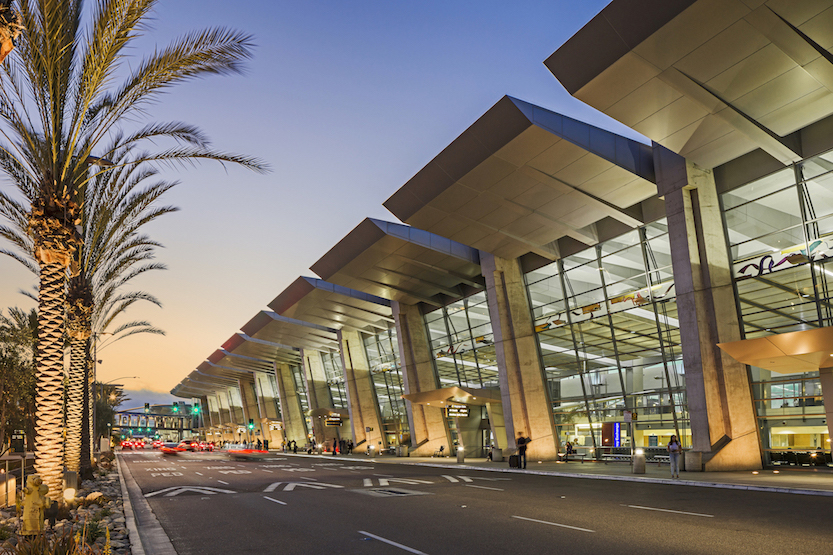Daily Business Report-Sept. 19, 2018
Terminal 2 at San Diego International Airport (Photo courtesy of Pablo Mason)
Report: Airport contributes
nearly $12 billion to regional economy
A new Economic Impact Study completed for San Diego International Airport indicates a dramatic increase in regional employment, payroll and economic impact as a result of the airport. The study quantifies the airport’s total economic contributions to the region at nearly $12 billion annually.
“This study highlights the airport’s role as far more than a vital transportation resource for the San Diego region,” said Kimberly Becker, Airport Authority president/CEO. “(the airport) is a regional asset that is also a major economic driver and job creator, constantly looking at ways to improve the passenger experience and help the region become increasingly global.”
The study measures the direct and indirect economic impacts generated by the airport. It compared 2017 data from the U.S. Department of Transportation, San Diego Tourism Authority, Airport Authority and on-airport tenants.
The study was last conducted in 2013 using data from 2012. Since then, the airport has undertaken a number of construction projects, including The Green Build Terminal 2 Expansion, Rental Car Center, Terminal 2 Parking Plaza, International Arrivals facility, and the on-airport roadway.
Total employment supported by the airport has increased by 31 percent over the past five years. In 2017 nearly 118,000 residents in the region were employed directly or indirectly due to the activities at the airport, generating nearly $3.9 billion in total annual payroll. Of total employment in San Diego County, the airport supports 5.7 percent of people employed in the region.
The growth in economic impact is largely due to the airport’s increase in passenger traffic. In 2012, the airport accommodated nearly 17.3 million passengers, which grew to nearly 22 million in 2017 passengers. Business and leisure visitors spend money while visiting the region, thereby helping support additional economic impacts. According to the San Diego Tourism Authority, visitors arriving by air spend an average of $835 per person per trip. In 2017, it is estimated that more than 5.9 million visitors to the region spent nearly $5 billion in the regional economy.
The full Economic Impact Study is available online. Click here
__________________
Design workshop to be held
Sept. 27 for 2 Chula Vista parks
The Port of San Diego and city of Chula Vista invite the public to attend a Sept. 27 Design Workshop for Harbor Park and Sweetwater Park, two future projects that will account for more than half of the new park space planned for the Chula Vista Bayfront project.
The workshop will provide an opportunity for the public and stakeholders to provide their input on how to best balance recreational wants and needs for these spaces with equally important efforts to preserve Chula Vista’s natural resources for future generations. Attendees will learn about the differences between these two future parks and be able to speak one-on-one with members of the design team about their priorities for each park.
The workshop will be held at 6 p.m. at the Chula Vista Public Library, Civic Center Branch, 365 F St., Chula Vista.
__________________
Navy seeks bigger surface ships for upgrades,
future weapons systems
ExecutiveGov
The U.S. Navy has formed a group that will define the design and purpose of the service’s next large surface ship, Defense News reported.
Rear Adm. Ron Boxall, director of the office of the Chief of Naval Operations Director of Surface Warfare, said the service seeks a ship that is big and flexible enough to be easily modified and equipped with energy-extensive weapons such as electromagnetic rail guns and laser systems.
The Navy also wants its future surface vessel to have removable panels, larger vertical launch system launchers and Raytheon’s AN/SPY-6 Air and Missile Defense Radar.
Boxall added that the service wants its new new ship to accommodate unmanned vehicles as the service begins deploying drones in its operations.
The Navy intends to initiate the acquisition process in 2019, then procure a new surface ship by 2023 or 2024.
__________________
SDEA sponsors program on
harassment prevention in workplace
San Diego Employers Association (SDEA) introduces a new program, “The Thriving Workplace: Harassment Prevention Training 2.0,” taking place on Wednesday, Oct. 24 at 10:30 am at SDEA.
The program will be led by workplace civility expert Catherine Mattice Zundel, founder of Civility Partners. For employers who have already held the mandatory Harassment Prevention Training, what comes next? Harassment Prevention Training 2.0 will help managers put into practice what they have learned. This new program takes the basic Harassment Prevention Training to the next level and helps employees to be empowered and knowledgeable in identifying and addressing harassment. Attendees will learn what reinforces negative behavior at work; how to step in when witnessing bad behavior; how to coach and stop employees who are engaging in bad behavior, and more.
Zundel will provide attendees with the tools and resources they need to create and reinforce behaviors that address problems proactively and cultivate respect in the workplace. The program costs $65 for SDEA members and $85 for nonmembers. Registration to this program is now open. To learn more and to register, visit www.sdeahr.org
__________________
General Atomics to host NASA
MAIA payload on satellite
NASA has tapped General Atomics’ electromagnetic systems business to host an aerosol pollutant measuring instrument on the company’s Orbital Test Bed-2 satellite.
General Atomics said it will provide integration and pre-launch processing services for the Multi-Angle Imager for Aerosols instrument, which will be launched to space in 2022 to study the connection between aerosol pollutants and human health problems, such as cardiovascular and respiratory issues.
Other support services that GA-EMS will perform for the MAIA launch include satellite testing, spacecraft and launch vehicle coordination, in-orbit checkout and on-orbit spacecraft operations enabling instrument operations.
Scott Forney, president of GA-EMS, said the company will offer its services in modular satellite design to support MAIA’s three to five-year mission to collect data on the effect of pollution on the human population.
NASA’s Langley Research Center is managing the MAIA platform under the Earth System Science Pathfinder Program.
__________________
Personnel Announcements
Briana Givens joins CaseyGerry law firm

CaseyGerry, a San Diego-based plaintiffs law firm, has named Briana Givens its newest associate attorney. Givens will work closely with CaseyGerry partner Frederick Schenk with a focus on serious personal injury and premises liability cases.
She joined CaseyGerry as a law clerk in 2016 and began her legal career after earning a fellowship from the San Diego County Bar Association Diversity Program, working as a summer associate for San Diego-based Andrews Lagasse Branch & Bell LLP.
While earning her J.D. from Thomas Jefferson School of Law, she worked as executive editor of Thomas Jefferson Law Review; served on the Law Student Outreach Committee; and earned numerous awards for academic excellence, including the Witkin Award for Academic Excellence, CALI Excellence for the Future Award, Earl B. Gilliam Scholarship and the 2017 National Black Law Students Association Young Women in Leadership Award.
Givens is a member of the Consumer Attorneys of San Diego, Lawyers Club of San Diego, the San Diego County Bar Association and the Earl B. Gilliam Bar Association.



